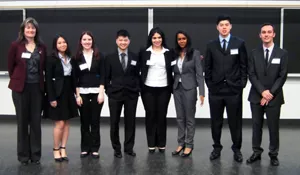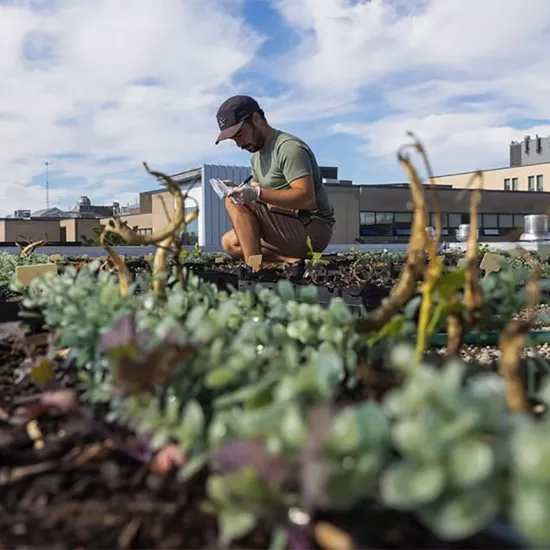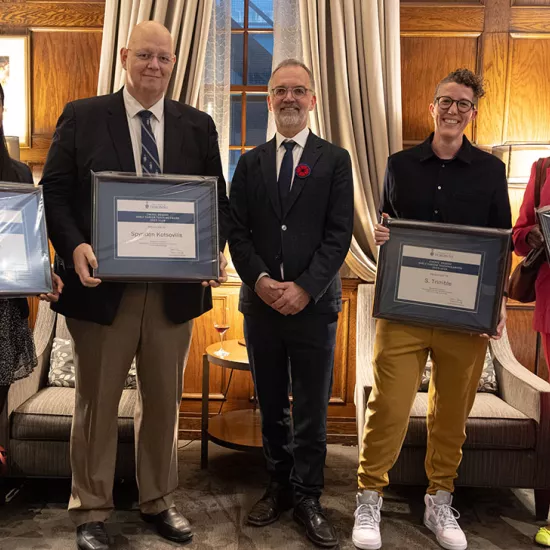UTM's Forensic Science Day showcases the science of bloodstains, DNA and bullets

After months of learning and researching in the field at their internships, forensic science students at the University of Toronto Mississauga shared their experiences at last Wednesday’s Forensic Science Day.
Students in FSC481, a mandatory fourth-year 200-hour internship course, explained the nature and results of the research projects they completed while interning at organizations such as the Centre of Forensic Sciences, the Centre for Addiction and Mental Health and the Hamilton Regional Forensic Pathology Unit. Taking place at the Instructional Centre, the event featured presentations by six students discussing everything from bloodstain patterns, to sex offender risk reassessment, to the physical symptoms of electrocution deaths.
Janujah Sivanandan discussed her research on the efficacy of three-dimensional scanning for documenting injuries during an autopsy. Specifically, she studied whether Artec Eva, a wireless handheld scanner that captures images in 3-D, is better than photographs and manual measurements for recording the location and size of injuries on a body, and the trajectories of bullets.
Guided by program instructor and forensic visualization specialist Eugene Liscio, Sivanandan arranged a mock autopsy in which a volunteer donned 11 temporary tattoos of various injury wounds all over her body. When scanning the wounds with the 3-D scanning device, she found that generally, she could capture more detailed information, with more accuracy and in less time than with traditional methods.
“3-D scanning enters a new paradigm for injury documentation during autopsies,” said Sivanandan in summarizing her research.
Victor Dang, meanwhile, shared his investigation into bloodstain pattern analysis, which involved determining the difference between two types of bloodstains found on clothing: impact, in which blood is projected by an external force, usually a gush or spurt from a wound; and expirated, which are expelled from the nose, mouth or airway. Specifically, he looked at whether a product called Phadebas, paper that can detect saliva on fabric or material, can accurately distinguish between expirated and impact blood on cotton and denim.
Mentored by a member of Peel Regional Police’s Forensic Identification Services, Dang enlisted six participants to donate blood and help with creating mock impact and expirated bloodstains onto the two types of fabric. The Phadebas paper was then placed onto the fabrics to test for the presence of amylase, an enzyme present in human saliva that is involved in digestion. His findings showed that testing paper could distinguish between the two different types of bloodstains.
“The application of this process can be used to either refute or confirm an individual’s story, and ultimately remove them as a potential suspect,” Dang said. “Phadebas paper should be considered for use in the field because of its efficiency and simplicity.”
The event also marked the 20th anniversary of the program, which began as the first of its kind in Canada. In the audience were the students’ teachers and mentors, graduates of the program, and members of the local forensic science community, including police officers, forensic pathologists, researchers and academics. Many of them also presented at the full-day event on topics such as forensic science trends in Europe, modern methods in forensic pathology, the forensic value of 3-D-printed firearms and new DNA analysis techniques.
In the opening address, Professor Deep Saini, U of T vice-president and UTM principal, celebrated its 20-year milestone, describing it as a top innovator in training in the field.
“This program today serves as the benchmark for everybody else. It is Canada’s leading forensic science university degree, and it’s getting better every day,” Saini said.



